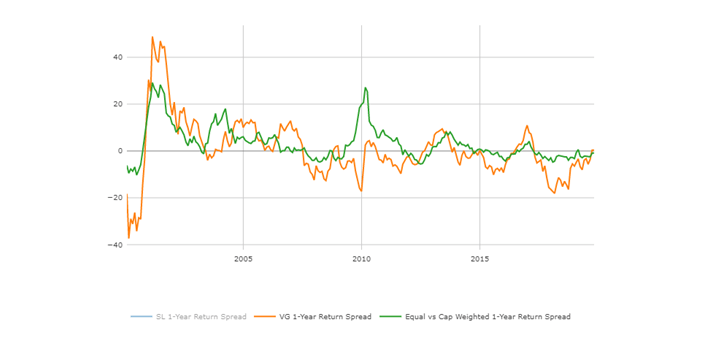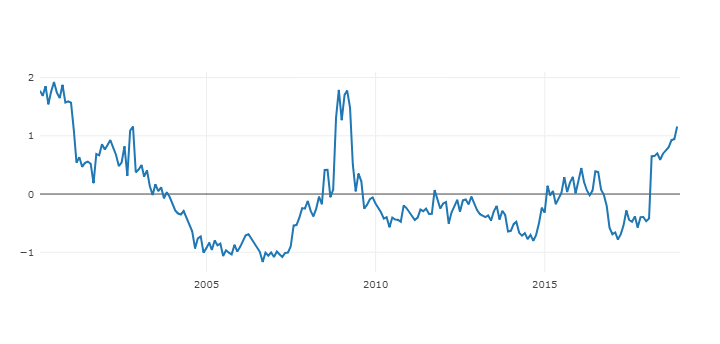
US economics, inflation, and the Fed
Inflation remains relatively high, but there is optimism that it is again starting to move lower. April producer prices were stronger than expected, and the pace of consumer price growth is still running well above the Federal Reserve’s target rate of 2%. However, there was some easing at the consumer level after the pace of price growth reaccelerated in the first quarter, and energy prices have recently weakened. This gives Wall Street hope that the central bank may still cut interest rates sometime in the second half of this year according to Value Line. Treasury yields retreated on this sentiment and ignited another bullish stretch for equities.
Nevertheless, several real economic indicators have come in below expectations, raising some concerns about the overall health of the economy. This includes softer retail sales, housing starts, and manufacturing output. GDP forecasts have thus been adjusted downward. While the initial estimates for Q2 gross domestic product (GDP) were overly optimistic, projecting growth in the 4’s, we’re now seeing revisions bringing expectations down to the low 3’s or even upper 2’s. There was also a downward revision of Q1 GDP figures, but it’s important to recognize the resilience in corporate earnings despite this softer economy. Companies have generally reported strong results, which is positive that businesses are managing margins well even with more sluggish economic growth figures. We could see a further boost to earnings if the current estimates for Q2 GDP come in on track according to Professor Siegel.
The Federal Reserve is still walking a tightrope. Clearly, more work needs to be done to bring inflation closer to the bank’s comfort level, but the Fed also must guard against slowing the economy too much. This would bring concerns about stagflation, which is a period of slowing growth amid a weakening labor market and still elevated inflation. There have been signs of fatigue among consumers, along with declines in the pace of residential construction and manufacturing activity.
With a successful first quarter earnings season in the rearview mirror, the focus will be on inflation and the Fed’s near-term monetary policy stance. In recent weeks, this has proven to be a “Goldilocks” scenario for equity investors. However, there remains some uncertainty about if and when the Fed will reverse monetary course.
Global economy
To add to good news, the May composite output PMI (global purchasing managers index ) rose a larger-than-expected 1.6-pts, with broad-based improvements across sectors and regions. The output PMI is now up for six consecutive months and stands at its strongest level in a year (53.3). However, given the survey’s recent volatility and limited accuracy, JP Morgan downplays its signal on GDP growth momentum. Indeed, it continues to track below the bank’s 2Q24 developed markets (DM) GDP forecast, an outcome that would be consistent with a moderation in overall global growth.
The PMI is most reliable in tracking the Euro area and the May gain prompted JP Morgan to raise our sights on GDP growth to a 1.5% annual rate for this quarter and next. While US business surveys have not tracked activity well in recent years, the coincident slide in the April PMI and ISM surveys raised concern. With the May PMI bouncing and April activity readings recording solid gains, JP Morgan’s forecast for a 2.3% annual rate current-quarter GDP gain remains on track.
Although global IP (industrial production) will be held back as China comes off the boil this quarter, the PMI suggests an anticipated recovery elsewhere is taking hold. The flash output PMI rose to its highest level in 23 months with gains registered across all countries surveyed. Overall the survey is aligned with a modest recovery in DM output growth this year, but the failure of the orders/inventory ratio to lift from depressed levels strikes a cautionary note. Output price pressure remains moderate. The output price PMI remains elevated relative to its pre-pandemic norm, but a rise in the survey during the first three months of this year has been partially reversed with declines in April and May.
More broadly this news sends a positive signal about the global industrial cycle with strong readings on exports from Taiwan and Korea aligning with a large gain in Japan machinery orders. If JP Morgan is right the May global manufacturing PMI due in early June will move higher despite a slowing China and reinforce the message that both the sectoral and regional breadth of the global expansion is increasing. The bank predicts the global economy to expand at a 2.7% annual rate this year.
Stock market
The equity markets in the US and around the globe feel great and the fact that we find ourselves in an election year only adds to optimism (see the Black Rock Student of the Market May Edition chart):

Moreover, even a popular notion of “sell in May and walk away” might not work that well this year. Just take a look at the election years averages versus regular years:

With the corporate earnings getting stronger not only in IT sector but in a broader market, we should expect the markets to stand their ground! Have a great summer!
The information and opinions included in this document are for background purposes only, are not intended to be full or complete, and should not be viewed as an indication of future results. The information sources used in this letter are: WSJ.com, Jeremy Siegel, Ph.D. (Jeremysiegel.com), Goldman Sachs, J.P. Morgan, Empirical Research Partners, Value Line, BlackRock, Ned Davis Research, First Trust, Citi research, HSBC, and Nuveen.
IMPORTANT DISCLOSURE
Past performance may not be indicative of future results.
Different types of investments and investment strategies involve varying degrees of risk, and there can be no assurance that their future performance will be profitable, equal to any corresponding indicated historical performance level(s), be suitable for your portfolio or individual situation, or prove successful.
The statements made in this newsletter are, to the best of our ability and knowledge, accurate as of the date they were originally made. But due to various factors, including changing market conditions and/or applicable laws, the content may in the future no longer be reflective of current opinions or positions.
Any forward-looking statements, information, and opinions including descriptions of anticipated market changes and expectations of future activity contained in this newsletter are based upon reasonable estimates and assumptions. However, they are inherently uncertain, and actual events or results may differ materially from those reflected in the newsletter.
Nothing in this newsletter serves as the receipt of, or as a substitute for, personalized investment advice. Please remember to contact Signet Financial Management, LLC, if there are any changes in your personal or financial situation or investment objectives for the purpose of reviewing our previous recommendations and/or services. No portion of the newsletter content should be construed as legal, tax, or accounting advice.
A copy of Signet Financial Management, LLC’s current written disclosure statements discussing our advisory services, fees, investment advisory personnel, and operations are available upon request.



























































































